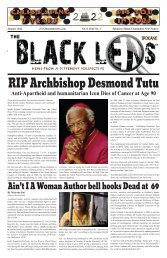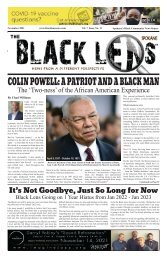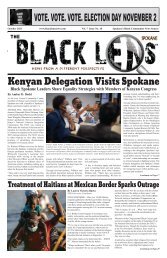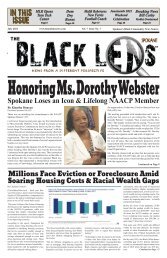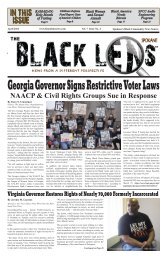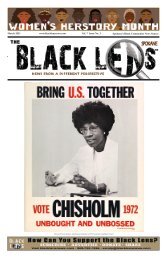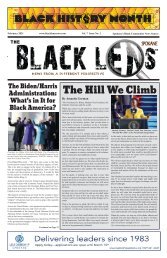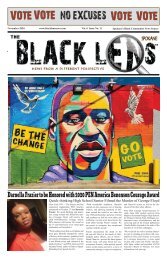Black Lens March 2020
The Black Lens is an independent community newspaper based in Spokane WA that is focused on the news, issues, events and people of importance to the Black community.
The Black Lens is an independent community newspaper based in Spokane WA that is focused on the news, issues, events and people of importance to the Black community.
Create successful ePaper yourself
Turn your PDF publications into a flip-book with our unique Google optimized e-Paper software.
Page 4<br />
<strong>March</strong> <strong>2020</strong><br />
www.blacklensnews.com<br />
The <strong>Black</strong> <strong>Lens</strong> Spokane<br />
YOU SHOULD KNOW<br />
(Or Things You Probably Didn't Learn In School)<br />
ART AND HISTORY<br />
Norma Merrick Sklarek<br />
Norma Merrick Sklarek was born April 15,<br />
1926 in Harlem, New York. Her father was<br />
a doctor and her mother was a seamstress<br />
both immigrating from Trinidad. An only<br />
child, Norma grew up in schools normally<br />
reserved for Caucasian children, but she<br />
was a standout in art, science, and mathematics.<br />
By having a close and loving relationship<br />
with her father, he was able to<br />
convince her that her art and math skills<br />
combined could mean great success in architecture.<br />
She attended Barnard College in 1944 as a<br />
one-year requirement for entrance into the<br />
School of Architecture at Columbia University.<br />
Her years at Columbia were difficult.<br />
While she came in green, many of her<br />
classmates were coming home from World<br />
War II and were more worldly, already possessing<br />
bachelor’s and master’s degrees.<br />
While most students were together completing<br />
projects, Norma worked on hers<br />
alone. “The competition was keen, but I<br />
had a stick-to-it attitude and never gave<br />
up”. Norma graduated from Columbia in<br />
1950 with a bachelor’s degree in Architecture,<br />
one of only two women and the first<br />
woman of Moorish descent ever to receive<br />
a degree in architecture.<br />
The real-world reality of her complexion<br />
plus being a woman began to manifest in<br />
her life. In her first attempts to be hired, she<br />
was rejected by nineteen firms. Ultimately<br />
her first position was junior draftsperson<br />
for the City of New York’s Department of<br />
Public Works. In 1954, Norma took the<br />
New York State architectural licensing<br />
exam and after a grueling four-day exam<br />
passed on her first attempt, becoming the<br />
first Moorish woman licensed as an architect<br />
not only in New York but in the whole<br />
country.<br />
Upon leaving for new employment she<br />
found that her former boss had been giving<br />
negative reviews about her employment<br />
history to prospective employers. She<br />
opined: “It had to be personal. He was not<br />
a licensed architect, and I was a young kid<br />
– I looked like a teenager – and I was <strong>Black</strong><br />
and a licensed architect.”<br />
By 1955 Norma went to the firm of Skidmore,<br />
Owings & Merrill (S.O.M.). For the<br />
first time in her professional career responsibility<br />
was shared with her and she saw<br />
more and more works land on her table<br />
while she taught at New York City Community<br />
College. Four years later she became<br />
the first ever Moorish woman to hold<br />
membership with the American Institute of<br />
Architects.<br />
She moved to California to be close to<br />
family and went to work for Gruen Associates<br />
of Los Angeles. Once again double<br />
standards would appear. Without a car she<br />
commuted with a Caucasian male co-worker<br />
who was always late for work prompting<br />
her new boss to question her commitment:<br />
“It took only one week before the boss<br />
came and spoke to me about being late. Yet<br />
he had not noticed that the young man had<br />
been late for two years. My solution was<br />
to buy a car since I, the highly visible employee,<br />
had to be punctual.”<br />
By 1962 Norma was the first ever Moorish<br />
woman to gain California’s state architect’s<br />
license and her work for Gruen gained her<br />
the executive level position of director of<br />
architecture (she was now down by law<br />
on both coasts). While there she taught at<br />
UCLA and USC as a member of the architectural<br />
faculty.<br />
After twenty years at Gruen, Norma left to<br />
become Vice-President of Welton Becket<br />
Associates and was directly responsible for<br />
Terminal One at Los Angeles International<br />
Airport (LAX), a project costing fifty-million<br />
dollars that prepared for the 1984<br />
Olympics. By 1985 she co-founded Siegel<br />
Skarek Diamond Architectural firm, the<br />
largest firm owned entirely by women. Unfortunately,<br />
the women saw less work and<br />
fewer large-scale commissions adversely<br />
affected their financial opportunities.<br />
Norma retired in 1992 with a simple<br />
architectural design philosophy: “architecture<br />
should be working on improving<br />
the environment of people in<br />
their homes, in their places of work,<br />
and their places of recreation. It should<br />
be functional and pleasant, not just in<br />
the image of the ego of the architect.”<br />
Her works include California Mart,<br />
Los Angeles; Fox Plaza, San Francisco;<br />
Park Center Commercial Complex,<br />
San Jose; San Bernardino City Hall;<br />
Commons-Courthouse Center, Columbus<br />
Indiana; The U.S. Embassy, Tokyo;<br />
Pacific Design Center, Los Angeles;<br />
by Bertoni Jones Bey<br />
Terminal One at LAX, Los Angeles;<br />
and Mall of America, Minneapolis.<br />
One of the most fascinating things about<br />
Norma is that she was a trailblazer in her<br />
field who reached the pinnacle of her work<br />
without ever having one single mentor. No<br />
one ever reached out to show her. “In architecture,<br />
I had absolutely no role model.<br />
I’m happy today to be a role model for others<br />
that follow”. Norma Merrick Sklarek<br />
passed away on February 6, 2012 in Pacific<br />
Palisades, California at the age of 85.<br />
Sources:<br />
pioneeringwomen.bwaf.org/norma-merrick-skarek;<br />
<strong>Black</strong> Heritage Day III –<br />
Jamiyo Mack.<br />
Mary Beatrice Davidson Kenner: Inventor of Women's Sanitary Belt<br />
(Source: blackthen.com; goodblacknews.<br />
com; revolvy.com) Mary Beatrice Davidson<br />
Kenner, born on May 17, 1912, was<br />
an African-American inventor most noted<br />
for her development of the sanitary belt.<br />
She was born in Monroe, North Carolina<br />
and came from a long line of inventors.<br />
Her father, Sidney Nathaniel Davidson<br />
(June 1890-November 1958), who she<br />
credited with inspiring her interest in discovering<br />
things, patented a clothing press<br />
that would fit into a suitcase, although he<br />
ultimately made no money on the invention.<br />
Her sister, Mildred Davidson Austin<br />
Smith (1916–1993), invented and commercially<br />
sold board games. Her grandfather<br />
invented a light signal for trains.<br />
In 1931 Kenner graduated from high<br />
school and earned a place at the prestigious<br />
Howard University, but was forced to drop<br />
out a year and a half into her course due to<br />
financial pressures. She took on odd jobs<br />
such as babysitting before landing a position<br />
as a federal employee. She continued<br />
inventing in her spare time.<br />
By 1957 Kenner had saved enough money<br />
for her first ever patent: a belt for sanitary<br />
napkins. It was long before the advent of<br />
disposable pads, and women were still using<br />
cloth pads and rags during their period.<br />
Kenner proposed "an adjustable belt with<br />
an inbuilt, moisture-proof napkin pocket,<br />
making it less likely that menstrual blood<br />
could leak and stain clothes." A company<br />
contacted her and expressed their interest<br />
in her idea. However, after they discovered<br />
the idea came from a <strong>Black</strong> woman, they<br />
turned her down. Kenner's invention was<br />
the precursor to self-adhesive maxi pads<br />
which wouldn't become readily available<br />
until the 1960s. It would be 30 years before<br />
the sanitary belt was patented.<br />
In addition to the sanitary belt, Kenner invented<br />
a serving tray after her sister was<br />
diagnosed with multiple sclerosis and had<br />
to get around with a walker, a toilet tissue<br />
holder that always made sure the loose end<br />
of the roll was within reach and a back<br />
washer that could be attached to the wall of<br />
a shower to help people reach the parts of<br />
their back that were hard to get to.<br />
Between 1956 and 1987 Kenner received<br />
five total patents for her household and<br />
personal item creations. She said she never<br />
intended to make money off of her inventions,<br />
but just wanted to make people lives<br />
easier. Kenner died on January 13, 2006.



